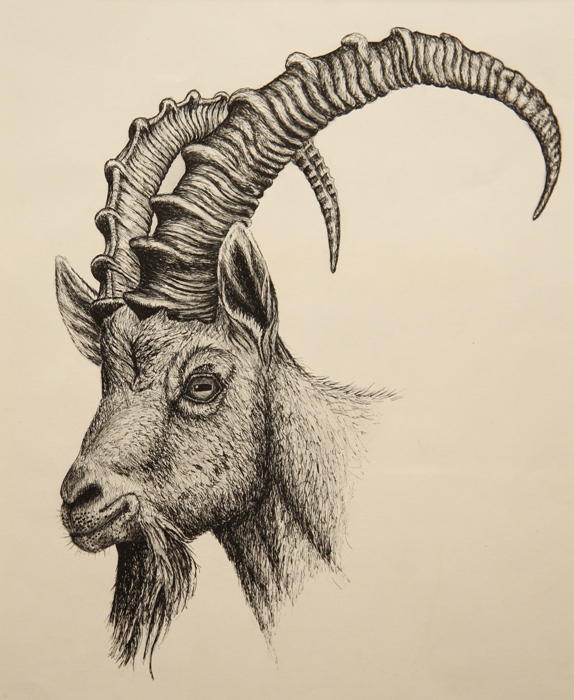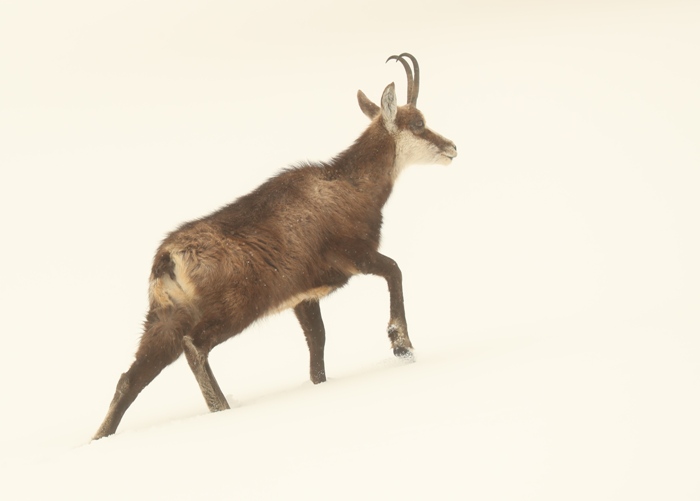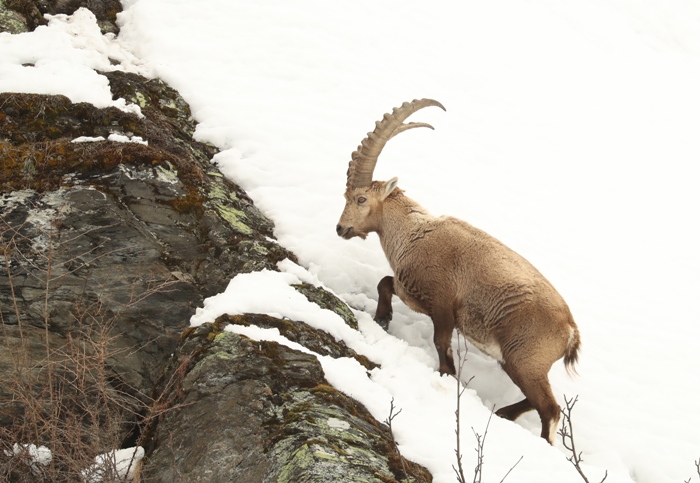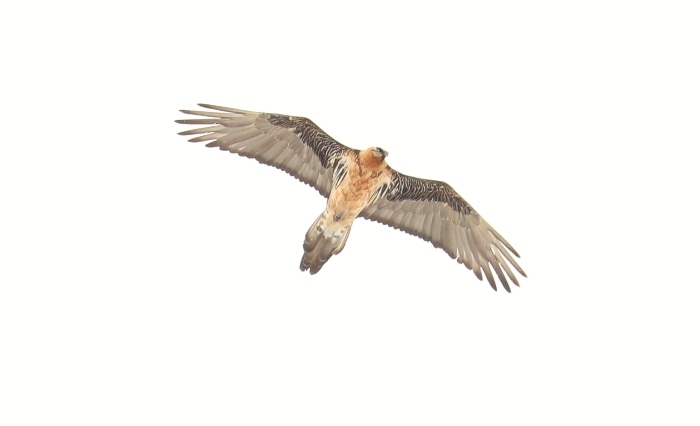AS SEEN IN





Home » In Search of Wild Ibex and Chamois in the French Alps
Wildlife artist Robert E Fuller braves avalanches and rocky slopes to photograph ibex in the wild for his paintings. In March, the artist took a guided tour through knee deep snow drifts in Les Houches, near Chamonix in the French alps to see this region’s remarkable wildlife.
I started drawing wildlife when I was 13 years old but it wasn’t until I was 15 before I considered myself any good. I remember opening a magazine and spotting a photograph of an ibex, a wild Alpine goat, with huge horns sweeping over its back in two great arching curls.

I couldn’t resist drawing it and spent hours replicating every twist of those impressive horns in pen and ink. Little did I know it would be 30 years before I caught up with a real ibex. Last month I visited the French Alps with my family. We were staying in Les Houches, near Chamonix, at the foot of the impressive 4,810m high Mont Blanc. While my wife took our two daughters skiing, I met up with a local wildlife guide named Fred Loux . He asked what I would like to see. I reeled off a list that included ibex, chamois, golden eagle and bearded vulture.
He looked worried when I added lynx and wolf to my wish list. But I was only joking. Although these predators inhabit the Alps, they are rare and almost impossible to spot. We set off to a mountain pass named Col des Montets, situated in the protected Reserve des Aiguilles Rouges, to look for chamois. After half an hour walking across deep snow using snow shoes and walking poles, we spotted our first chamois high above us on the edge of a forest. Chamois are a small, buff-coloured goat-like creature closely related to antelope with short, curved horns. Nimble, fast and remarkably sure-footed, the species is exclusive to Europe’s highest mountains. In winter they live lower down in the forests, but they are very wary and difficult to study.
We headed towards them, crossing dangerously unstable ground where avalanches had spilled boulders of snow and ice across our path. The avalanche risk factor was at level four out of five so we had to tread very carefully. It started to snow and a mist rolled in. The herd disappeared like ghosts. Unfortunately the whiteout didn’t clear before it was time to head back. The next day we planned to look for ibex. Ibex are nearly double the weight of chamois and over 20 cm taller. They live much higher up the mountain and so our tour involved a 1,000m climb to rocky mountainous terrain where they spend winter.
We set off from Servoz, a small village at 700m above sea level, where there was little snow. The first signs of spring were already showing, violet and primrose flowers peeking through the leaf litter. After a steep hour’s climb we were back in the snow zone. Pine marten, fox and chamois tracks crisscrossed the ground. The higher we climbed, the deeper the snow became. Our snow shoes were crucial, spreading our weight across a wider surface area, which enabled us to walk without sinking to our waists.

Fred, my mountain guide, was a slim, wiry man all of 10 stone. He seemed unstoppable as he scrambled up the mountainside, battling through the undergrowth and striding across rocky streams with barely a pause. By contrast my 6ft-2-inch 13-stone frame with an extra stone and a half worth of cameras on my back was hindering progress. Each time I stepped into one of his footprints, I sank 8” further into the 2 metre deep snow. It was exhausting! With every step I was conscious of the weight of my boots, snow shoes and the extra kilogram of snow I was carrying on each foot. At one point I disappeared up to my waist into a hole where a tree had fallen. The only thing that kept me going was the thought of seeing ibex. Eventually a wide expanse of sky opened in front of us. From here the view of the Alpine peaks was amazing. I regained my breath and scanned the landscape with my binoculars. High above us was a flock of birds. I expected Alpine chuffs, but it turned out to be a flock of woodpigeons migrating through a mountain pass.
A bird of prey called in the distance. I scanned the rock face above us and there was the unmistakable silhouette of a golden eagle, swooping by. It was calling which meant that there was more than one. It circled round before flying right over our heads. Its mate appeared and followed it, effortlessly soaring across the valley and out of sight without using a single wing beat. Suddenly there was the sound of a crack of thunder. Snow avalanched down from the rock face, reminding us of the dangers hidden in this beautiful landscape.

I scanned again and then I spotted it: my first ibex. It was a huge bearded male with sweeping horns and darkish brown coat standing about half a mile away on the other side of a gorge. The sight of it was rejuvenating, even though we couldn’t reach this one. We climbed on for another 40 minutes and reached La Chorde, the ibex’s wintering grounds. I spotted three impressive males, weighing over 100kg each and measuring 3ft high at the shoulder, standing on a windswept rock face above us. Fred suggested we stop for lunch, but eating was the last thing on my mind. I wanted to photograph the ibex first.
There had been an avalanche on the slope below them so it was too dangerous to cross. Instead we planned to approach from above. This involved climbing a nearby ridge and walking underneath a cliff face where a few small trees would provide handholds. From a distance it looked feasible – it was only 400 yards away. But once we were there everything was steeper, bigger, harder and more dangerous. With just 30 yards to go I stumbled and started sliding downhill fast. I grasped at nearby branches, but they tore the skin from my hands so I let go. Then I looked down. There was a drop of hundreds of feet down into a rocky stream below. I grabbed the last branch in sight and held on. I was relieved it didn’t give way.
I regained my composure and climbed back up. There was now just a steep gorge between the ibex and myself. But I was at eye level and close enough to photograph them. I edged forward, afraid of disturbing them. But Fred assured me that unlike the chamois, ibex are fairly relaxed around people. The males barely acknowledged me as I clicked off a series of photographs. The ibex were eating dead grasses and browsing on the branches of small trees. I watched one lumbering up to its waist in snow to reach a few meagre twigs – what an effort for so little a reward!
Every now and then the thunder of an avalanche broke the silence. I realised how hungry I was and as I finally tucked into my lunch a pair of rare bearded vultures flew over.These giant birds of prey, are called lammergeier, which means ‘lamb vulture’ in German. They measure up to four foot tall and have a wingspan of over seven feet. Historically they suffered from a gruesome reputation for taking lambs, calves and even small children, but they are actually scavengers and live off a diet that consists mainly of bones and bone marrow. They are known to drop picked-over carcasses from tremendous heights to break the bones up into swallow-able pieces.

We stayed for over an hour and a half watching the ibex, before deciding it was time to head home. But focused on our quest to find ibex, we hadn’t realised what a dangerous spot we were now in. There was a gorge on one side and a cliff on the other. I wouldn’t have fancied taking either route back even without snow. We set off, climbing up and curving around the top of the cliff. I put my walking pole into the snow – it disappeared – as did my hand and my forearm. The snow was seriously deep and kept collapsing beneath me as I reached the pinnacle of the ridge.
I remember telling my wife that skiing was far too dangerous for me. In hindsight skiing would have been a much safer option! But it was worth it. At the head of the gorge a huge male ibex was asleep under the shelter of a granite cliff. I spent about three quarters of an hour slowly edging closer to photograph him. My hands were shaking so much I couldn’t hold my camera still – I couldn’t tell if this was from vertigo or exhaustion!
Then, mission more than accomplished, we set off on the long trek back. I fell more times that day than I have fallen in my entire life, but my spirits were high. As we got back to our chalet, we joked that I was like the cumbersome ibex, struggling in waist-deep snow whilst my guide was the nimble chamois, scampering over the top of the drifts with ease. It wasn’t the most flattering comparison, but certainly true!
I flew with Easy Jet to Geneva from Liverpool and then took a shared mini-bus from the airport to Les Houches, Chamonix, at the foot of Mont Blanc
Fred Loux is a member of the Cie des guides de Chamonix. I booked him through the Compagnie des Guides de Chamonix. Follow the link for more information about the guides available.
None found
Sign up to my newsletter for updates on news, wildlife sightings, products and more directly to your inbox
AS SEEN IN





THE ROBERT FULLER GALLERY
FOTHERDALE FARM
THIXENDALE, MALTON
YO17 9LS
UNITED KINGDOM
TEL: +44 (0) 1759 368355
EMAIL: mail@robertefuller.com
3 Responses
Wow, what an adventure! Such beautiful pictures of the ibex and chamois. I am envious that you saw the lammergeier. I’ve only seen them on television.
We have turkey vultures here in the US. They arrive in mid-to-late February and leave in late October. Not as impressive as your vultures, but any bird I see is interesting to me.
Thank you and it was!
great story ,wonderful pictures , very happy that You have chance to see them all in one go , i was in le contamines 2 yrs ago very close to les houches ,and i never forget when bearded volture flew over my head for the first and last time ,he was that big that literally cover sun for few second ,my dream come true that day , i have been few times after that in alps but never got chance to see him again , many hours wondering in this tough hiking trials with heavy gear ,but without luck , i think cause his illusive nature is somewhere on top my bird list , truly enjoyed Your story ,all the best Robert